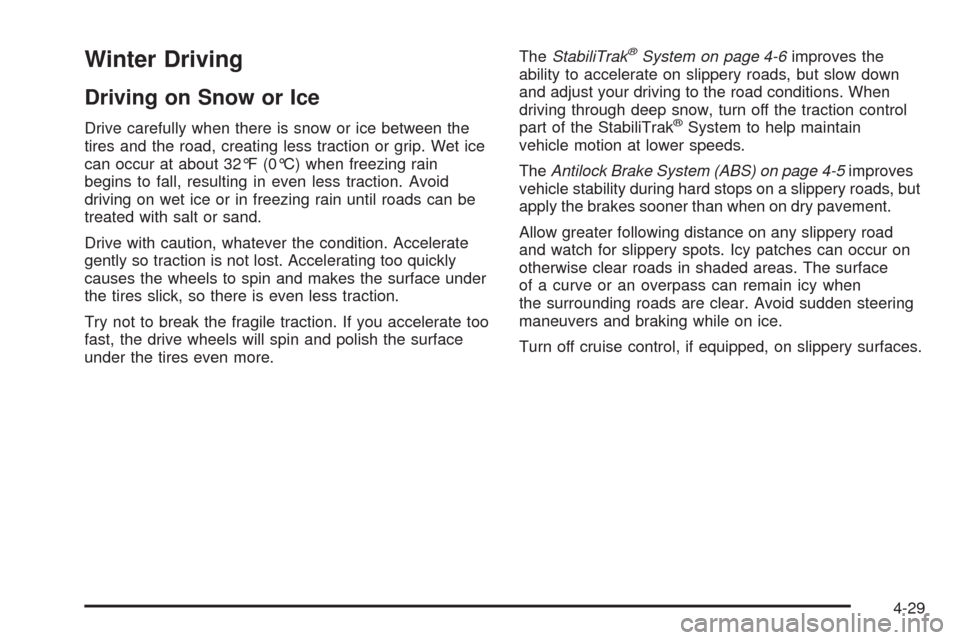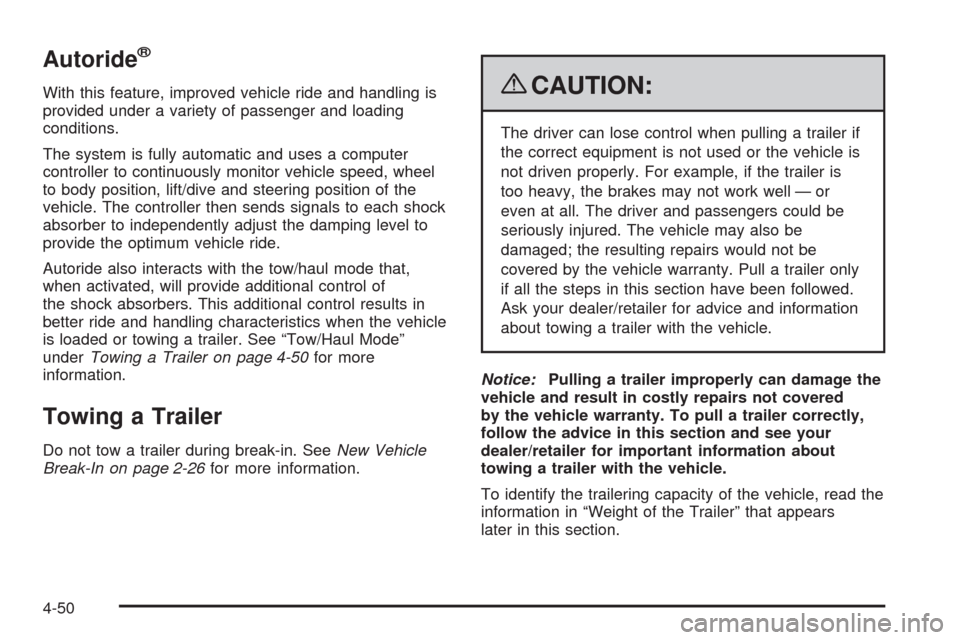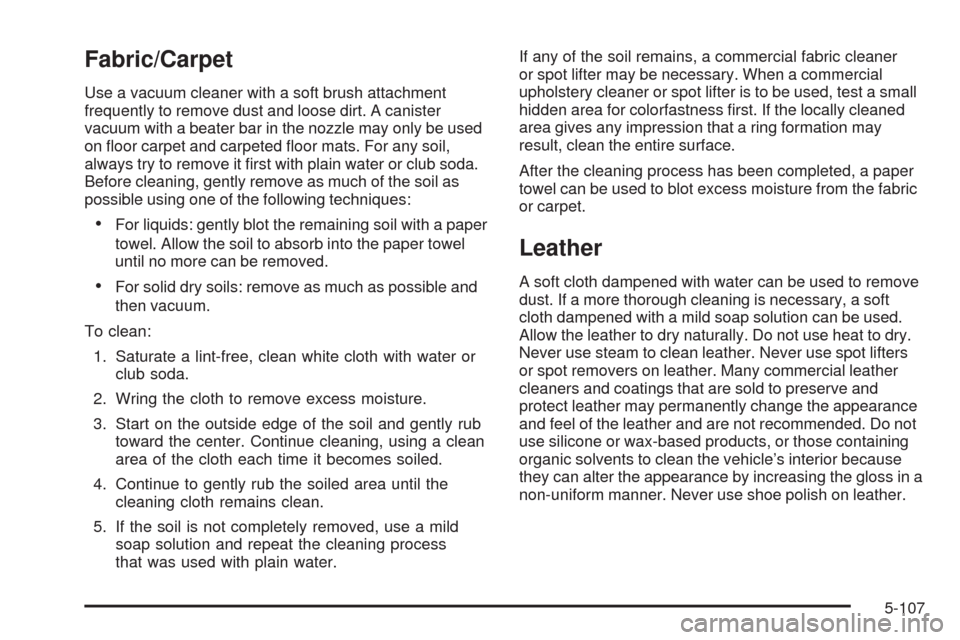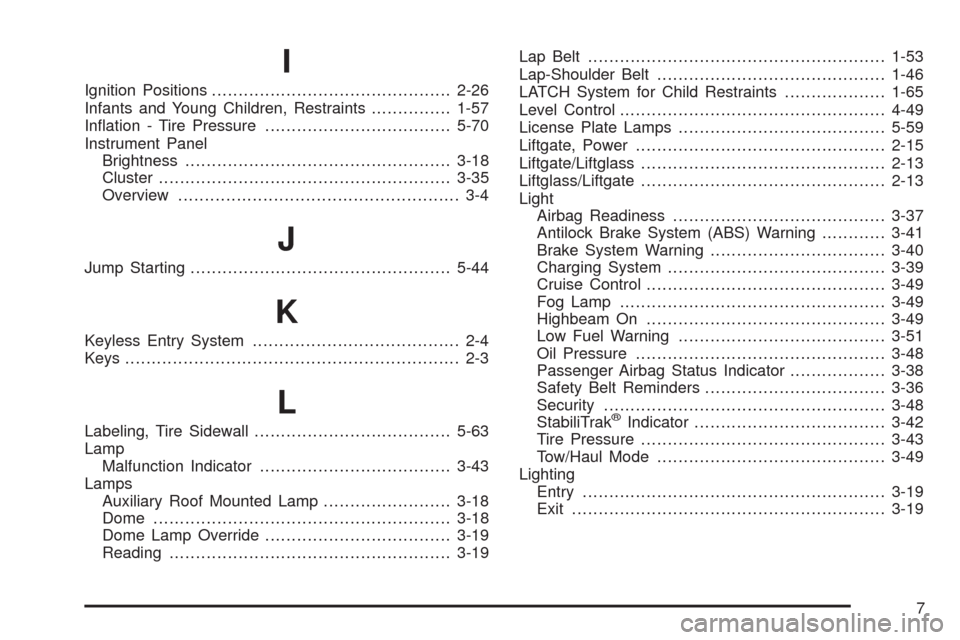2009 CHEVROLET TAHOE ABS
[x] Cancel search: ABSPage 357 of 574

Winter Driving
Driving on Snow or Ice
Drive carefully when there is snow or ice between the
tires and the road, creating less traction or grip. Wet ice
can occur at about 32°F (0°C) when freezing rain
begins to fall, resulting in even less traction. Avoid
driving on wet ice or in freezing rain until roads can be
treated with salt or sand.
Drive with caution, whatever the condition. Accelerate
gently so traction is not lost. Accelerating too quickly
causes the wheels to spin and makes the surface under
the tires slick, so there is even less traction.
Try not to break the fragile traction. If you accelerate too
fast, the drive wheels will spin and polish the surface
under the tires even more.TheStabiliTrak
®System on page 4-6improves the
ability to accelerate on slippery roads, but slow down
and adjust your driving to the road conditions. When
driving through deep snow, turn off the traction control
part of the StabiliTrak
®System to help maintain
vehicle motion at lower speeds.
TheAntilock Brake System (ABS) on page 4-5improves
vehicle stability during hard stops on a slippery roads, but
apply the brakes sooner than when on dry pavement.
Allow greater following distance on any slippery road
and watch for slippery spots. Icy patches can occur on
otherwise clear roads in shaded areas. The surface
of a curve or an overpass can remain icy when
the surrounding roads are clear. Avoid sudden steering
maneuvers and braking while on ice.
Turn off cruise control, if equipped, on slippery surfaces.
4-29
Page 378 of 574

Autoride®
With this feature, improved vehicle ride and handling is
provided under a variety of passenger and loading
conditions.
The system is fully automatic and uses a computer
controller to continuously monitor vehicle speed, wheel
to body position, lift/dive and steering position of the
vehicle. The controller then sends signals to each shock
absorber to independently adjust the damping level to
provide the optimum vehicle ride.
Autoride also interacts with the tow/haul mode that,
when activated, will provide additional control of
the shock absorbers. This additional control results in
better ride and handling characteristics when the vehicle
is loaded or towing a trailer. See “Tow/Haul Mode”
underTowing a Trailer on page 4-50for more
information.
Towing a Trailer
Do not tow a trailer during break-in. SeeNew Vehicle
Break-In on page 2-26for more information.
{CAUTION:
The driver can lose control when pulling a trailer if
the correct equipment is not used or the vehicle is
not driven properly. For example, if the trailer is
too heavy, the brakes may not work well — or
even at all. The driver and passengers could be
seriously injured. The vehicle may also be
damaged; the resulting repairs would not be
covered by the vehicle warranty. Pull a trailer only
if all the steps in this section have been followed.
Ask your dealer/retailer for advice and information
about towing a trailer with the vehicle.
Notice:Pulling a trailer improperly can damage the
vehicle and result in costly repairs not covered
by the vehicle warranty. To pull a trailer correctly,
follow the advice in this section and see your
dealer/retailer for important information about
towing a trailer with the vehicle.
To identify the trailering capacity of the vehicle, read the
information in “Weight of the Trailer” that appears
later in this section.
4-50
Page 396 of 574

Driving On Grades
Reduce speed and shift to a lower gearbefore
starting down a long or steep downgrade. If the
transmission is not shifted down, the brakes might have
to be used so much that they would get hot and no
longer work well.
Vehicles can tow in D (Drive). Shift the transmission to
a lower gear if the transmission shifts too often under
heavy loads and/or hilly conditions.
The tow/haul mode may be used if the transmission
shifts too often. SeeTow/Haul Mode Light on page 3-49.
When towing at high altitude on steep uphill grades,
consider the following: Engine coolant will boil at a lower
temperature than at normal altitudes. If the engine is
turned off immediately after towing at high altitude on
steep uphill grades, the vehicle may show signs similar to
engine overheating. To avoid this, let the engine run while
parked, preferably on level ground, with the automatic
transmission in P (Park) for a few minutes before turning
the engine off. If the overheat warning comes on, see
Engine Overheating on page 5-34.
Parking on Hills
{CAUTION:
Parking the vehicle on a hill with the trailer
attached can be dangerous. If something goes
wrong, the rig could start to move. People can be
injured, and both the vehicle and the trailer can be
damaged. When possible, always park the rig on a
�at surface.
If parking the rig on a hill:
1. Press the brake pedal, but do not shift into P (Park)
yet. Turn the wheels into the curb if facing downhill
or into traffic if facing uphill.
2. Have someone place chocks under the trailer
wheels.
3. When the wheel chocks are in place, release the
regular brakes until the chocks absorb the load.
4. Reapply the brake pedal. Then apply the parking
brake and shift into P (Park).
4-68
Page 507 of 574

Fabric/Carpet
Use a vacuum cleaner with a soft brush attachment
frequently to remove dust and loose dirt. A canister
vacuum with a beater bar in the nozzle may only be used
on �oor carpet and carpeted �oor mats. For any soil,
always try to remove it �rst with plain water or club soda.
Before cleaning, gently remove as much of the soil as
possible using one of the following techniques:
For liquids: gently blot the remaining soil with a paper
towel. Allow the soil to absorb into the paper towel
until no more can be removed.
For solid dry soils: remove as much as possible and
then vacuum.
To clean:
1. Saturate a lint-free, clean white cloth with water or
club soda.
2. Wring the cloth to remove excess moisture.
3. Start on the outside edge of the soil and gently rub
toward the center. Continue cleaning, using a clean
area of the cloth each time it becomes soiled.
4. Continue to gently rub the soiled area until the
cleaning cloth remains clean.
5. If the soil is not completely removed, use a mild
soap solution and repeat the cleaning process
that was used with plain water.If any of the soil remains, a commercial fabric cleaner
or spot lifter may be necessary. When a commercial
upholstery cleaner or spot lifter is to be used, test a small
hidden area for colorfastness �rst. If the locally cleaned
area gives any impression that a ring formation may
result, clean the entire surface.
After the cleaning process has been completed, a paper
towel can be used to blot excess moisture from the fabric
or carpet.
Leather
A soft cloth dampened with water can be used to remove
dust. If a more thorough cleaning is necessary, a soft
cloth dampened with a mild soap solution can be used.
Allow the leather to dry naturally. Do not use heat to dry.
Never use steam to clean leather. Never use spot lifters
or spot removers on leather. Many commercial leather
cleaners and coatings that are sold to preserve and
protect leather may permanently change the appearance
and feel of the leather and are not recommended. Do not
use silicone or wax-based products, or those containing
organic solvents to clean the vehicle’s interior because
they can alter the appearance by increasing the gloss in a
non-uniform manner. Never use shoe polish on leather.
5-107
Page 561 of 574

A
Accessories and Modi�cations............................ 5-3
Accessory Power Outlets.................................3-20
Adding a Snow Plow or Similar Equipment.........4-39
Adding Equipment to Your Airbag-Equipped
Vehicle.......................................................1-96
Additives, Fuel................................................. 5-6
Add-On Electrical Equipment...........................5-114
Adjustable Throttle and Brake Pedal..................2-30
Air Cleaner/Filter, Engine.................................5-20
Air Conditioning......................................3-22, 3-24
Airbag
Passenger Status Indicator...........................3-38
Readiness Light..........................................3-37
Airbag System................................................1-81
Adding Equipment to Your Airbag-Equipped
Vehicle...................................................1-96
How Does an Airbag Restrain?......................1-88
Passenger Sensing System...........................1-90
Servicing Your Airbag-Equipped Vehicle..........1-96
What Makes an Airbag In�ate?......................1-87
What Will You See After an Airbag In�ates?....1-88
When Should an Airbag In�ate?....................1-86
Where Are the Airbags?...............................1-83
Antenna, Rear Side Window...........................3-139
Antenna, XM™ Satellite Radio Antenna
System.....................................................3-139
Antilock Brake System (ABS)............................. 4-5
Antilock Brake, System Warning Light................3-41Appearance Care
Aluminum or Chrome-Plated Wheels.............5-111
Care of Safety Belts...................................5-108
Chemical Paint Spotting..............................5-112
Cleaning Exterior Lamps/Lenses..................5-109
Fabric/Carpet............................................5-107
Finish Care...............................................5-110
Finish Damage..........................................5-112
Instrument Panel, Vinyl, and Other Plastic
Surfaces...............................................5-108
Interior Cleaning........................................
5-105
Leather....................................................5-107
Sheet Metal Damage..................................5-112
Tires........................................................5-112
Underbody Maintenance.............................5-112
Washing Your Vehicle.................................5-109
Weatherstrips............................................5-108
Windshield, Backglass, and Wiper Blades......5-110
Appointments, Scheduling Service.....................7-10
Ashtray.........................................................3-21
Audio System.................................................3-82
Audio Steering Wheel Controls....................3-137
Navigation/Radio System, see Navigation
Manual.................................................3-114
Radio Reception........................................3-138
Rear Seat Audio (RSA)...............................3-135
Setting the Clock.........................................3-83
Theft-Deterrent Feature...............................3-137
XM™ Satellite Radio Antenna System...........3-139
1
Page 567 of 574

I
Ignition Positions.............................................2-26
Infants and Young Children, Restraints...............1-57
In�ation - Tire Pressure...................................5-70
Instrument Panel
Brightness..................................................3-18
Cluster.......................................................3-35
Overview..................................................... 3-4
J
Jump Starting.................................................5-44
K
Keyless Entry System....................................... 2-4
Keys............................................................... 2-3
L
Labeling, Tire Sidewall.....................................5-63
Lamp
Malfunction Indicator....................................3-43
Lamps
Auxiliary Roof Mounted Lamp........................3-18
Dome ........................................................3-18
Dome Lamp Override...................................3-19
Reading.....................................................3-19Lap Belt........................................................1-53
Lap-Shoulder Belt...........................................1-46
LATCH System for Child Restraints...................1-65
Level Control..................................................4-49
License Plate Lamps.......................................5-59
Liftgate, Power...............................................2-15
Liftgate/Liftglass..............................................2-13
Liftglass/Liftgate..............................................2-13
Light
Airbag Readiness........................................3-37
Antilock Brake System (ABS) Warning............3-41
Brake System Warning.................................3-40
Charging System.........................................3-39
Cruise Control.............................................3-49
Fog Lamp ..................................................3-49
Highbeam On.............................................3-49
Low Fuel Warning.......................................3-51
Oil Pressure...............................................3-48
Passenger Airbag Status Indicator..................3-38
Safety Belt Reminders..................................3-36
Security.....................................................3-48
StabiliTrak®Indicator....................................3-42
Tire Pressure..............................................3-43
Tow/Haul Mode...........................................3-49
Lighting
Entry.........................................................3-19
Exit...........................................................3-19
7